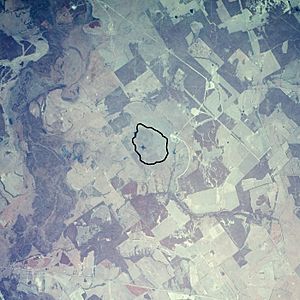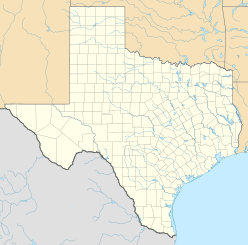Marquez crater facts for kids

Cretaceous rocks at center of Marquez dome
|
|
| Impact crater/structure | |
|---|---|
| Diameter | 12.7 km (8 mi) |
| Age | 58 ± 2 million years |
| Exposed | No |
| Drilled | Yes |
| Location | |
| Location | Marquez, Texas, United States |
| Coordinates | 31°17′N 96°18′W / 31.283°N 96.300°W |
| Country | United States |
| Region | US-TX |
| State | Texas |
| District | Leon County, TX |
| Access | |
The Marquez crater is a special place in Leon County, Texas, near the town of Marquez, Texas. It is about 177 km (110 mi) northeast of Austin, Texas, in the United States. This crater was formed a very long time ago when a large space rock, called a meteorite, crashed into Earth.
Even though it's a crater, you can't see it from the surface. It's hidden underground! Scientists know it's there because they have studied the rocks and land in the area. The crater is quite large, measuring about 12.7 km (8 mi) across. It was formed around 58 million years ago, during a time called the Paleocene epoch.
Contents
What is an Impact Crater?
An impact crater is a bowl-shaped hole left on a planet or moon's surface. It forms when a large object from space, like a meteorite or asteroid, crashes into it.
How Craters Form
When a space rock hits Earth, it travels at incredible speeds. This creates a huge explosion. The force of the impact pushes rocks and soil outwards. It also melts some of the ground.
- First, a temporary hole forms. This is much bigger than the space rock itself.
- Then, the ground beneath the impact bounces back. This can create a central peak in the middle of the crater.
- Finally, the edges of the crater might collapse inwards. This forms the final bowl shape.
Over millions of years, craters on Earth can get worn away. Wind, water, and even plants can fill them in. This makes them hard to see.
The Marquez Crater: A Hidden Giant
The Marquez crater is a great example of a hidden crater. It is not visible on the surface today. This is because it has been covered by layers of soil and rock over millions of years.
Why We Can't See It
Most impact craters on Earth are not easy to spot. Our planet is very active. Weather, erosion, and even plate tectonics can change the landscape. These processes slowly erase the signs of ancient impacts. The Marquez crater is buried deep underground.
The Marquez Dome
Even though the main crater is hidden, there's a clue on the surface. It's called the Marquez Dome. This dome is a raised area of land. Scientists believe it is part of the central peak of the original crater. This peak was pushed up when the meteorite hit. Over time, erosion wore away the layers above it, revealing this dome. It's like seeing the tip of an iceberg!
Discovering the Hidden Crater
How do scientists know there's a crater if it's hidden? They use special methods to study the ground.
Drilling and Rocks
One way is by drilling deep into the Earth. Scientists take samples of rocks from different depths. They look for signs of impact. These signs include:
- Shocked quartz: This is a type of mineral that forms under extreme pressure. It's a clear sign of an impact.
- Melted rocks: The intense heat from an impact can melt rocks. These melted rocks then cool and harden.
- Unusual rock layers: The layers of rock might be jumbled or out of order. This shows a sudden, powerful event happened.
Scientists have drilled in the Marquez area. They found these kinds of evidence. This confirmed that a meteorite impact created the structure.
Studying Gravity and Magnetism
Scientists also use tools to measure gravity and magnetism. Large underground structures, like craters, can affect these forces. By mapping these changes, scientists can create a picture of what's hidden beneath the surface. This helps them find buried craters like Marquez.
Why Study Impact Craters?
Studying impact craters helps us understand Earth's history. It also teaches us about space.
- Earth's Past: Craters show us how often Earth has been hit by space objects. They can also tell us about major events that shaped our planet.
- Life on Earth: Some very large impacts have changed Earth's climate. They might have even affected the history of life on our planet.
- Space Exploration: By studying craters on Earth, we learn more about craters on other planets and moons. This helps us understand the solar system.
The Marquez crater is an important piece of this puzzle. It helps scientists learn more about ancient impacts in Texas and beyond.


